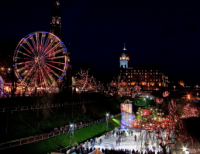

Alongside the twinkling Christmas lights and enormous tree, outdoor ice rinks have become part and parcel of many UK cities' Christmas scene. However, the unseasonable warm weather may leave many cities out in the cold, with fears that ice rinks will be replaced by piles of slush.
Mark Nelson, who runs the ice rink at Somerset House in central London, says that 6C is the optimum temperature. Any warmer, and increasing amounts of energy are required to maintain the ice. Any lower and "little, if any" energy is used, with "zero consumption" being reached at 1C. Once the air temperature falls below zero, natural icing produces a "harder" ice.
"On average, the ice rink requires energy for 50% of the time," said a Somerset House spokeswoman. "The ice is made of purified water, which ensures that it is frozen more quickly and is more resistant to melting." A computer monitors the quality and temperature, avoiding any needless refrigeration. This saves both energy for the environment, as well as money for the operator's budget. In 2007, Salford city council said it spent £10,000 on electricity running its 200-square-metre Winter Wonderland rink.
However, there is no fear of a wash-out at the outdoor ice rink in Lytham Square, Blackpool, where synthetic ice is used, which is a melt-free alternative. Although synthetic ice receives criticism, Professional ice-skater Natalia Pestova insisted that the high-density plastic panels that can be locked together like a jigsaw are just as good as the real thing.